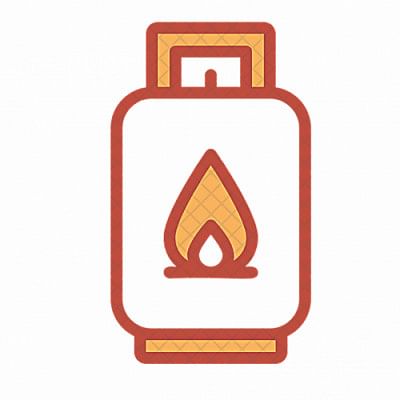LPG industry in a tough spot

The market of liquefied petroleum gas (LPG) is facing a bizarre dilemma.
There is growing demand for LPG in the country and this unexplored sphere has huge potential. At the same time, there is stiff competition among many market players. And the more the market is expanding, the stiffer the competition among the LPG companies is getting, industry insiders say.
This competition, however, is helping consumers get new cylinders at less than half the production price. But it is increasing the financial burden on companies.
An imported cylinder of 12 kg capacity costs a company Tk 2,000 to Tk 2,200 but it is being sold at Tk 900 to Tk 1,100 just to hook new customers, according to industry insiders.
Whereas countries like China and India have only four and three LPG companies respectively, in Bangladesh 19 are already operating and four are in the pipeline, putting the industry in a tough spot in terms of attaining market share.
Moreover, the government has issued licences to about 53 companies.
“It is right that the investors are now counting losses. But they are hoping that one day they will turn the business around,” says Md Jakaria Jalal, general manager (sales) of Bashundhara LP Gas Ltd.
He says new players came up with investments in an unplanned way without proper assessment of the actual market demand. Therefore, their business capacities have remained unutilised, according to Jalal.
Due to the high capital-intensive nature of the industry, he says, only companies with a long-term vision will be able to survive.
The LPG market grew significantly in Bangladesh since 2009 after the government stopped providing pipeline gas connections to households as the country’s natural gas reserve is depleting fast. Also, the use of LPG in rural areas is increasing due to rising standards of living.
The industry is largely import-oriented as 95 percent of the total LPG is imported.
During 2013-14, the LPG market witnessed a boom with many big companies entering the market. The construction of satellite plants for LPG storage and expansion of retailer networks contributed to an expanding market.
As of now, the annual LPG consumption in the country has risen to around 10 lakh tonnes and the demand is projected to increase to more than 25 lakh tonnes by 2025 and 35 lakh tonnes by 2030, industry insiders say.
LPG business in a tightrope
While the LPG industry is estimated to grow further, with so many industry players in the foreseeable future, survival and profit for the companies have become a big concern. There are also some unhealthy practices such as unreasonable price wars.
“The companies have invested their money by borrowing bank loans. So, there is a chance of bankruptcy if the return is not ensured. A big blow is eminent for the industry. LPG industry will become a sick industry if proper action is not taken right now,” says Jalal.
Shamsul Haque Ahmed, chief executive officer of Omera Petrolium Ltd, says, “The industry is very capital intensive. The return will come gradually. LPG operators are not in good shape right now. Market is oversupplied. It is unhealthy for the market. Countries like Japan, Turkey, Vietnam and Sri Lanka once had many companies but now they have three to five.”
He says illegal operators who are cross-filling are a major problem and such practices should be stopped. “It is increasing alarmingly. We want strong action. It is hampering the business growth.”
“We have to act very business-like. We have to conduct healthy business. The government is also positive,” Jalal says.
Mohammad Yasin Arafat, director of Jamuna Gas, says considering the market, four to five companies are enough to meet the demand.
“A lot of companies have been given licences. There will be a financial burden when all start operation. And there might be some illegal businesses to cut down the cost. This should not be allowed,” he adds.
Way forward
Industry people say it is time for the government to come up with an energy roadmap so that investors can act properly.
For the industry to flourish, they say, bureaucratic tangles should be reduced and for this an LPG cell should be formed immediately which was recommended around 10 years ago. There should be a one-stop centre to lessen the bureaucratic red-tape, they urge.
They say most of the companies’ mother storage is at Mongla port area where they cannot bring the large LPG-carrying vessels due to the low depth of the port. To cover this shortcoming, the importers use twice the number of ships.
“The cost of LPG will fall drastically once we have deep sea port. Now, we can bring a maximum of 3 to 5 thousand tonnes. When we can bring 40,000 tonnes, it would certainly reduce the cost of LPG,” says Shamsul Haque Ahmed.
Monzur Morshed Siddiqui, managing director of Total Bangladesh, says the role of the government is very important because industrialists do not know the energy roadmap.
“We need to know the roadmap to understand the future share of LPG in the energy mix. The government should reveal an energy roadmap so that people can invest in a prudent way.”
He also suggests some guidelines for the market to ensure that the end users consume the product at the right price.
Monzur Morshed says five percent VAT is a blow to the LPG industry. It is a necessity product, so VAT should not be applied, he adds.
About the competition of the companies, Nasrul Hamid, state minister for power, energy and mineral resources, says, “Our policy is not to say no to anyone. We keep it open for all. Those who sustain will remain in the market.”
“In a democratic country, we cannot restrict the opportunity for a few companies or persons as it may create controversy,” he says.
However, every company should come to the market after a feasibility study.
He adds saying although the roadmap is yet to be formulated, issues such as affordability, uninterrupted service and cost of opportunity of different fuels are being examined.
“We are now trying to chalk out a formula to bring the price under regulation,” Nasrul says.
He says currently the mechanism to reach the consumers is complex. There should be dedicated LPG dealers and they must have licence, he adds.
“The less the gap (between the producer and consumer) is, the cheaper the gas price will be. And the consumers will be interested then,” he says optimistically.


 For all latest news, follow The Daily Star's Google News channel.
For all latest news, follow The Daily Star's Google News channel. 



Comments